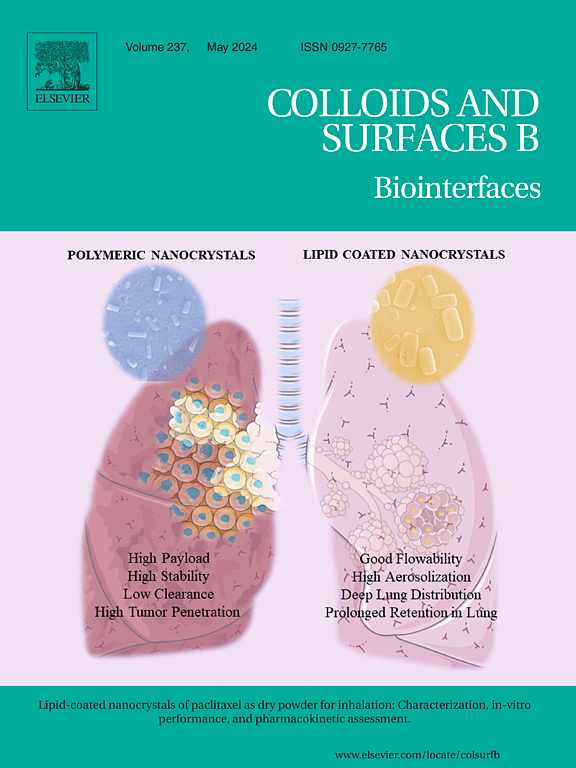地塞米松前药环糊精聚集体有效缓解实验性自身免疫性葡萄膜炎
IF 5.6
2区 医学
Q1 BIOPHYSICS
引用次数: 0
摘要
非感染性葡萄膜炎(NIU)仍然是视力障碍的重要原因,通常使用糖皮质激素治疗。然而,目前的糖皮质激素植入存在相当大的副作用,包括眼压升高和白内障。为了克服这些限制,我们合成了一种新的前药,地塞米松没食子酸酯(DG),它具有地塞米松(DEX)的强大抗炎能力,并具有没食子酸(GA)的强抗氧化活性,有助于保护眼部组织免受氧化应激。将DG配制成环糊精微粒悬浮液滴眼液,旨在有效地逐步分解和渗透眼部组织。在实验性自身免疫性葡萄膜炎(EAU)模型中,DG悬浮液滴眼液的治疗效果与减少剂量的常规DEX滴眼液相当,可显著减轻眼前和眼后炎症。值得注意的是,DG制剂大大降低了眼压升高和糖皮质激素相关的不良反应。这些发现支持了DG悬浮液滴眼液作为一种更安全、有效和对患者友好的治疗方法的潜力。本文章由计算机程序翻译,如有差异,请以英文原文为准。
Dexamethasone prodrug cyclodextrin aggregates effectively alleviate experimental autoimmune uveitis
Noninfectious uveitis (NIU) remains a significant cause of vision impairment, typically managed with glucocorticoids. However, current glucocorticoid implants present considerable side effects, including elevated intraocular pressure and cataracts. To overcome these limitations, we synthesized a novel prodrug, dexamethasone gallate (DG), which possesses the powerful anti-inflammatory ability of dexamethasone (DEX) and exhibits strong antioxidant activity of gallic acid (GA) that helps protect ocular tissues against oxidative stress. DG was formulated into cyclodextrin microparticle suspension eye drops, designed to progressively disintegrate and penetrate ocular tissues effectively. In experimental autoimmune uveitis (EAU) models, DG suspension eye drops demonstrated comparable therapeutic efficacy to conventional DEX eye drops at reduced dosages, significantly reducing anterior and posterior ocular inflammation. Notably, DG formulations substantially minimized intraocular pressure elevation and glucocorticoid-related adverse effects. These findings support the potential of DG suspension eye drops as a safer, efficient, and patient-friendly therapeutic alternative for treating NIU.
求助全文
通过发布文献求助,成功后即可免费获取论文全文。
去求助
来源期刊

Colloids and Surfaces B: Biointerfaces
生物-材料科学:生物材料
CiteScore
11.10
自引率
3.40%
发文量
730
审稿时长
42 days
期刊介绍:
Colloids and Surfaces B: Biointerfaces is an international journal devoted to fundamental and applied research on colloid and interfacial phenomena in relation to systems of biological origin, having particular relevance to the medical, pharmaceutical, biotechnological, food and cosmetic fields.
Submissions that: (1) deal solely with biological phenomena and do not describe the physico-chemical or colloid-chemical background and/or mechanism of the phenomena, and (2) deal solely with colloid/interfacial phenomena and do not have appropriate biological content or relevance, are outside the scope of the journal and will not be considered for publication.
The journal publishes regular research papers, reviews, short communications and invited perspective articles, called BioInterface Perspectives. The BioInterface Perspective provide researchers the opportunity to review their own work, as well as provide insight into the work of others that inspired and influenced the author. Regular articles should have a maximum total length of 6,000 words. In addition, a (combined) maximum of 8 normal-sized figures and/or tables is allowed (so for instance 3 tables and 5 figures). For multiple-panel figures each set of two panels equates to one figure. Short communications should not exceed half of the above. It is required to give on the article cover page a short statistical summary of the article listing the total number of words and tables/figures.
 求助内容:
求助内容: 应助结果提醒方式:
应助结果提醒方式:


